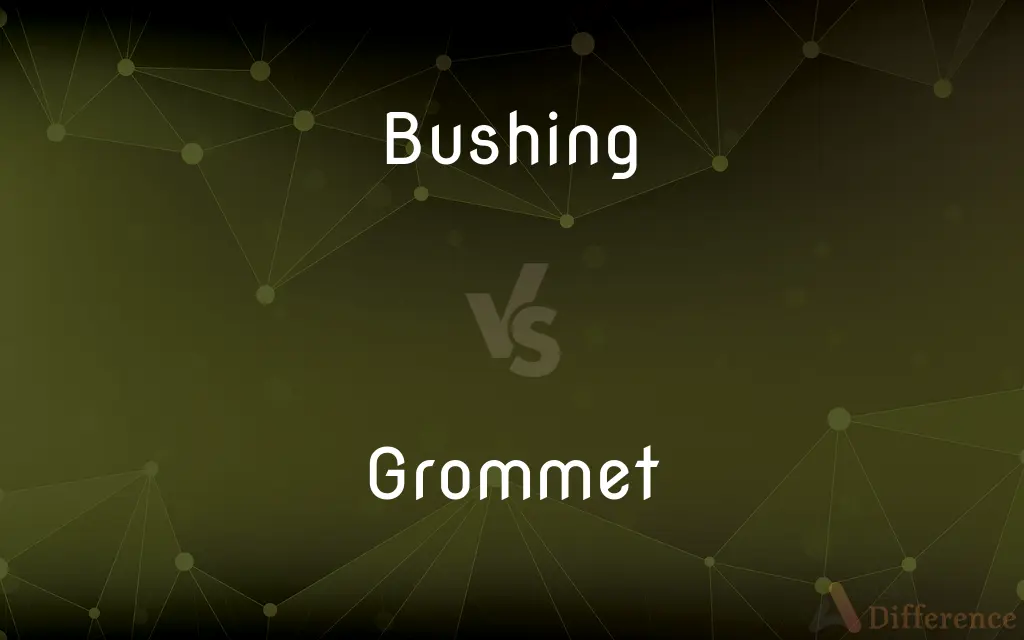Bushing vs. Grommet — What's the Difference?
By Maham Liaqat & Fiza Rafique — Updated on April 3, 2024
A bushing is a cylindrical liner designed to reduce friction and wear within a hole, often supporting a rotating shaft, whereas a grommet is a ring inserted into a hole through thin material, typically to prevent tearing or abrasion.

Difference Between Bushing and Grommet
Table of Contents
ADVERTISEMENT
Key Differences
Bushings are primarily used in mechanical applications to provide a smooth surface for moving parts, reducing friction and extending the lifespan of machinery. They are often made from metal, plastic, or rubber, depending on the application's requirements. Grommets, on the other hand, are used to protect cables, wires, or any objects passing through a hole in metal, plastic, or other thin materials. They serve to cushion and protect from sharp edges, preventing wear and tear.
The design of a bushing is simple yet effective, focusing on durability and the ability to withstand high pressures and temperatures. This makes them essential components in various industrial and automotive applications. Whereas grommets are designed with flexibility in mind, allowing for easy installation and removal, which is particularly useful in applications where cables or wires may need to be rerouted or replaced.
Bushings are typically press-fit into housing or boreholes and do not require any adhesives or fasteners, making them a permanent solution in many applications. Grommets, however, are designed to be easily inserted and removed from pre-drilled holes, offering a more temporary or adjustable solution for passing cables and wires through surfaces.
The selection between a bushing and a grommet often depends on the application's specific needs, including the type of movement (rotational vs. static), the materials involved, and the environmental conditions (such as exposure to chemicals or extreme temperatures). Grommets are particularly useful in electrical installations and panel mountings, where protecting sensitive wiring is crucial.
Despite their differences, both bushings and grommets play crucial roles in protecting components and materials from damage. Whether reducing friction and wear in mechanical systems or preventing the abrasion of cables and wires, their importance cannot be understated in ensuring the longevity and reliability of equipment and installations.
ADVERTISEMENT
Comparison Chart
Application
Reduce friction in moving parts
Protect cables/wires from abrasion
Material
Metal, plastic, rubber
Rubber, plastic, metal
Design Focus
Durability, withstand pressure/temperature
Flexibility, ease of installation
Installation
Press-fit, permanent
Inserted into holes, removable
Use Case
Mechanical systems, automotive
Electrical installations, panel mountings
Compare with Definitions
Bushing
Can be made from various materials.
The plastic bushing was chosen for its resistance to corrosion.
Grommet
Can be easily installed and removed.
The grommet's design allowed for quick installation without any tools.
Bushing
Liner for reducing friction in mechanical parts.
The engineer replaced the worn bushing to ensure the machine ran smoothly.
Grommet
A ring for protecting materials from hole edges.
He inserted a grommet to prevent the cable from fraying against the sharp metal edge.
Bushing
Made to support rotating shafts.
Each rotating shaft in the gearbox is equipped with a durable bushing.
Grommet
Typically used to protect cables and wires.
Grommets were placed along the edge of the desk to route computer cables safely.
Bushing
Essential for the longevity of machinery.
Regularly checking and replacing bushings can significantly extend a machine's operational life.
Grommet
Allows for easy cable management.
Using grommets made organizing the various wires in the entertainment center much easier.
Bushing
Often press-fit for a secure placement.
The bushings were press-fit into the housing, eliminating the need for adhesive.
Grommet
Provides a cleaner look to installations.
The use of grommets gave the office's cable management system a neat and professional appearance.
Bushing
A fixed or removable cylindrical metal lining used to constrain, guide, or reduce friction.
Grommet
A grommet is a ring or edge strip inserted into a hole through thin material, typically a sheet of textile fabric, sheet metal or composite of carbon fiber, wood or honeycomb. Grommets are generally flared or collared on each side to keep them in place, and are often made of metal, plastic, or rubber.
Bushing
(Electricity) An insulating lining for an aperture through which a conductor passes.
Grommet
An eyelet placed in a hole to protect or insulate a rope or cable passed through it or to reinforce the hole.
Bushing
An adapter threaded to permit joining of pipes with different diameters.
Grommet
A tube surgically implanted in the eardrum to drain fluid from the middle ear.
Bushing
(mechanical engineering) A type of bearing, a cylindrical lining designed to reduce friction and wear inside a hole, often used as a casing for a shaft, pin or hinge.
Grommet
A young or inexperienced surfer or skateboarder
Mega moves that make gods out of grommets
Bushing
(mechanical engineering) An elastic bearing used as a type of vibration isolator, commonly made of rubber. An interface between two parts, damping the movement and the energy transmitted.
Grommet
A reinforced eyelet, as in cloth or leather, through which a fastener may be passed.
Bushing
(mechanical engineering) A threaded bushing: a fastener element that is inserted into an object, usually to add a threaded hole in a softer or thin material.
Grommet
A small metal or plastic ring used to reinforce such an eyelet.
Bushing
(electrical engineering) A lining for an opening through which a conductor passes, providing insulation and mechanical protection for the conductor.
Grommet
(Nautical) A loop of rope or metal used for securing the edge of a sail to its stay.
Bushing
An adapter for joining pipes of different size.
Grommet
A reinforced eyelet, or a small metal or plastic ring used to reinforce an eyelet.
Bushing
Present participle of bush
Grommet
(nautical) A ring formed of a single strand of rope, laid in three times round, fastening the upper edge of a sail to its stay.
Bushing
The operation of fitting bushes, or linings, into holes or places where wear is to be received, or friction diminished, as pivot holes, etc.
Grommet
(flags) An eyelet at the hoist end of a flag, used to fasten the flag to its halyard.
Bushing
A bush or lining; - sometimes called a thimble. See 4th Bush.
Grommet
A young or inexperienced surfer, skateboarder, or snowboarder.
Bushing
An insulating liner in an opening through which conductors pass
Grommet
A boy serving on a ship.
Bushing
A cylindrical metal lining used to reduce friction
Grommet
(transitive) To insert a grommet into.
Grommet
(transitive) To fasten using a grommet.
Grommet
(intransitive) To apply grommets.
Grommet
A ring formed by twisting on itself a single strand of an unlaid rope; also, a metallic eyelet in or for a sail or a mailbag. Sometimes written grummet.
Grommet
A ring of rope used as a wad to hold a cannon ball in place.
Grommet
Fastener consisting of a metal ring for lining a small hole to permit the attachment of cords or lines
Common Curiosities
Are all grommets made of rubber?
No, grommets can be made from rubber, plastic, or even metal, depending on their intended use.
Can bushings be used in electrical applications?
While bushings are primarily mechanical components, specific types are designed for electrical insulation purposes.
How do you choose between a bushing and a grommet?
The choice depends on the application's needs—whether it's for reducing friction (bushing) or protecting cables (grommet).
Can a grommet be used outdoors?
Yes, many grommets are designed to be UV and weather-resistant for outdoor use.
Do grommets affect the performance of cables?
Grommets do not affect cable performance; they protect the cables from physical damage.
Can grommets be customized?
Yes, grommets come in various sizes and materials and can be customized to fit specific requirements.
Is it easy to replace a bushing?
Replacing a bushing can be straightforward or complex, depending on its location and the application's design.
Can bushings be lubricated?
Yes, some bushings require lubrication to function correctly, while others are designed to be self-lubricating.
Are bushings only for industrial applications?
No, bushings are used in various settings, including automotive, industrial, and even household appliances.
How long do bushings last?
The lifespan of a bushing depends on its material, application, and environmental conditions, but they are generally designed for long-term use.
Are there different types of grommets for different materials?
Yes, grommets are designed to work with various materials, including thin metal, plastic, and wood, with specific types optimized for each.
Do grommets come in different colors?
Yes, grommets are available in a range of colors, allowing for aesthetic customization as well as functional use.
Share Your Discovery

Previous Comparison
Linen vs. Jute
Next Comparison
Hotel vs. MotelAuthor Spotlight
Written by
Maham LiaqatCo-written by
Fiza RafiqueFiza Rafique is a skilled content writer at AskDifference.com, where she meticulously refines and enhances written pieces. Drawing from her vast editorial expertise, Fiza ensures clarity, accuracy, and precision in every article. Passionate about language, she continually seeks to elevate the quality of content for readers worldwide.
















































